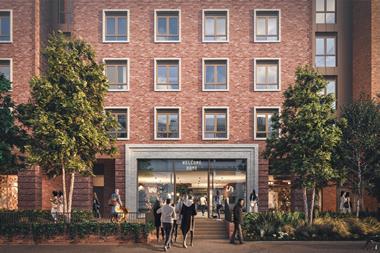It’s a risky business trying to predict the future. But more dangerous than that is going forward without a long-term plan. And with many retail developments taking more than a decade from conception to completion, 2028 is not a date in the dim, distant future – it’s just around the corner.
The world of retail moves quickly and because of the turmoil in the markets at present, many businesses are being forced to focus on the here and now. But wider trends are also emerging that will shape the way we do business in the future. Since it started 20 years ago, Retail Week has seen many changes but also many constants and the big players that had the long-term vision then are the ones reaping the rewards today.
In property, many of the issues that are at the forefront of landlords’ and retailers’ minds now will become even more pertinent in the decades ahead. In 1988, the concept of out-of-town retail was relatively young; ever since then, the balance between the level of development in town centres compared with out-of-town locations has constantly shifted and developers will always need to stay ahead of the game with their new schemes if they are to keep footfall flowing.
The big issues that the retail industry of 20 years ago did not have to grapple with are the very 21st-century challenges of the internet and sustainability and these are likely to be the emerging themes of the next 20 years.
Richard Hyman, independent retail consultant and founder of Verdict Research, says: “In 20 years’ time, the internet will account for around 15 per cent of the retail market, out-of-town retail will account for 30 per cent, 10 per cent will be neighbourhood stores and about 45 per cent will be taken up by the high street.”
Government drives and a mature out-of-town market have shifted the focus of development back to towns and cities. But with the completion of more than 13 big, retail-led urban regeneration projects set for this year alone, how many more centres need new schemes? Ten years of boom-time has left retailers with no shortage of urban space to choose from, but in the out-of-town market there are landlords struggling to let all their units too.
Many experts forecast that the wave of in-town developments of the past few years is also the way of the future. “A change in planning attitude is simply not on the cards,” says CB Richard Ellis director of retail research Mark Teale. ”If anything, the concern to protect traditional town centre shopping from competition is increasing. There is little likelihood of planning constraints on out-of-town grocery and bulky goods development being relaxed, either – indeed quite the reverse. Whatever the outcome of the current turmoil in financial markets, the potential for an increase in the rate of development activity in the UK remains extremely limited.”
Possibly the most discussed but least easily predicted feature of our age is the internet. Retailers have consistently underestimated the impact it has had on their businesses. The challenge and the opportunity is to forecast where it will take us in the future. For retailers this means trying to envisage how their business will develop over time and whether bricks or clicks will be the priority in 2028.
Retailers are still on a steep learning curve in terms of how the online channel fits into their approach, but, by 2028, the dust will have settled and a new culture of retail will be well under way.
“I think it’ll only get stronger,” says managing director of property investment group F&C Paul Herrington. “In 20 years’ time, we’ll have a generation coming through that’s used to shopping on the internet. This could mean smaller shops in certain locations and more showroom style shops where you can order products online.”
But not everyone sees the same amount of potential in the internet. “There are a lot of fanciful and spurious figures about the share the internet has now,” says Hyman. “At the moment, the internet accounts for less than 5 per cent of retail sales and in 20 years’ time it will have reached maturity in terms of the share it takes, at about 15 per cent.”
The best course of action for most retailers will be a multichannel approach. This will take time and there will be casualties along the way, but the seeds for this new age in retail are being sown today.
The future’s green
The green movement has gathered considerable momentum in the past five years and retail is one of its main focuses. Due to the nature of the industry, a new scheme may take a decade to plan and build, so the shape of retail property depends on the thinking patterns of today’s landlords and property directors.
Energy Performance Certificates – which will rate commercial buildings on how energy efficient they are – are to be unveiled in stages this year and will lay the foundations for future developments, but it is also crucial that landlords and retailers grasp the nettle.
“Sustainability has only really been an issue for the past two years,” explains BCSC chief executive Michael Green. “But I think everybody will grasp the opportunity. It’ll become more and more important to think about sustainability and this will become the norm as retailers begin to see some of the commercial benefits.”
Green cites current initiatives such as collecting rain water to use in toilet facilities and re-using hot air that has been circulating in a retail area to heat the residential element. These techniques are in use in a few centres in the UK already and, according to Green, will be the norm for new builds by 2028.
However, it’s not just green initiatives that are taking off – a new generation of shopping centre is emerging. The days when all that was needed was a roof and a good retail offer are over as consumer demands become ever more sophisticated. The type of developments that are now coming through – the wide open spaces and abundance of natural light in projects such as Liverpool One and Eden in High Wycombe – are the shape of things to come. For any future shopping centre to succeed, it will need to encompass residential and leisure features, as well as a sound retail offer.
Shoppers are becoming more demanding, more sophisticated and more aspirational. The challenge for developers and retailers is to make new centres as diverse, convenient and pleasurable an experience as possible. Centres will need to be as strong on their non-retail offering as the shopping they offer, bringing in leisure facilities and catering to attract and retain consumers.
“There will be a change to the focus of retailing in shopping centres,” says John Wood, retail development director at shopping centre operator The Mall. “The style of retailing will have changed and, from a landlord’s point of view, we’ve got to make ourselves a part of that. The art is delivering a comfortable experience for people.”
Designing centres with a mixed offering will become increasingly important between now and 2028 because of a shift in the culture of retail and leisure, according to Shelley Sandzer senior partner Trevor Shelley. He says: “What we’re seeing now is a massive amount of growth of leisure within schemes and high streets. Twenty years ago, landlords refused to accept leisure and catering because they thought they were lower class.”
Cushman & Wakefield head of retail John Strachan says: “As shoppers, we all crave a safe and pleasant environment, but now the places where we shop are becoming the places where we live and work too. Developers will need to achieve differentiation to achieve the diversity required by planners and regeneration bodies.”
In the past 30 years, an average of 13 million sq ft (1.2 million sq m) of retail space has been added in the UK each year. Whether or not this growth can continue unabated for another 20 years is far from certain. The onus for landlords in 20 years’ time may be on redeveloping existing centres and high streets to maximise the assets they already have.
“The retail property market has enjoyed a phenomenal run, but people in the retail property industry are in denial and don’t understand that we’re seeing the retail industry reaching physical maturity,” says Hyman. “We’re not going to see a repeat of the physical expansion in the way that we have for the past three decades.”


























No comments yet